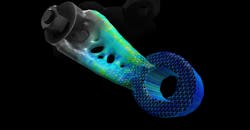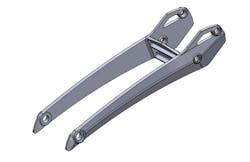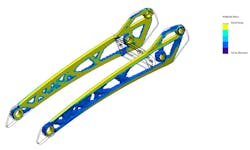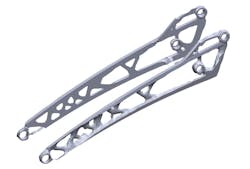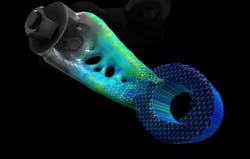How to “Grow” a 3D-Printed Part
The difference between “man-made” and “natural” creations is that man creates parts in an ideal scenario and nature continues to create in harsh and unlikely environments. For example, humans design buildings that are square (even on all sides) and uniform. This could lead to unnecessary supports or over constrained features.
Nature, on the other hand, grows structures like trees or coral in odd shapes and around obstacles, regardless of what is in its path. Nature does not over-constrain or add needless features. As it grows, it is testing the loads and boundaries of its design, and in the end the structure is as strong and stable as a skyscraper. With the rise of 3D printing and advanced computer-aided design (CAD) systems, we humans are now able to create unlikely structures that are inspired not by design, but by nature.
What is Topology Optimization?
For topology optimization, an initial part design is needed for the software to chip away at to create a lightweight (but still structurally sound) part.
Topology optimization is a simulation tool in modern CAD software designed to help create a near-optimized part. The simulation methods vary from software to software—it can be an additive or subtractive process. Some chisel away at the old design, removing material that is not crucial to strength or structure. Others grow parts from scratch until the design has reached an optimal structure. Solidworks, for example, uses the subtractive process implementing the Tosca optimization engine. “We felt the subtractive method was most attractive to our customers… with existing geometry you want to refine,” said Stephen Endersby, director of product portfolio management at Solidworks. “With Tosca, we also have the technology that has a track record in-house. So, it was a good, safe solution for our users.”
The topology optimization turns the design into a mesh. The software simulation applies loads and constraints to the mesh and removes elements that offer no structural or manufacturing benefit.
After the simulation, you have a part with unique features that is both lightweight and strong. Using additive manufacturing production methods, parts like this can be produced.
The software works by turning the design space into a mesh. It undergoes the simulation process complete with user-defined loads, constraints, and boundary conditions. The software analyzes the stiffness of each individual element and cuts out the elements that offer no structural or manufacturing benefit. The process performs several iterations until the part meets all constraints and global compliance. The global compliance defines the stiffness of the component by analyzing the original design shape and how it performs under the user-defined loads.
The software provides a deviation between the original and the optimized defiance, and the user can define the cut-off point for each element. You want to maintain the lowest deviation possible. The user can apply geometry constraints to limit the aggressiveness of the optimized design. This helps the user ensure the part can still be manufactured via machining or 3D printing methods.
Growing Structures with Live Parts
The method of topology optimization is still not an organic one. It is like a sculptor chipping away at a statue—i.e., taking a completed design and fine-tuning it. Desktop Metals has created a tool for users known as Live Parts, which is an experimental software that instead of chipping away at a design, grows parts organically.
Live Parts is a new software tool applies morphogenic principles and advanced simulation to create strong shapes and lightweight parts which are grown like plants or bones.
Desktop Metals is a metal 3D printing solutions company that is trying to create 3D-printed metals faster and more cost-effectively, and is a reliable tool for engineers and manufacturers. Live Parts is the company’s latest software release. The tool applies morphogenic principles and advanced simulation to create strong shapes and lightweight parts. The user defines the load points, the mounting points, and the overall volume constraints; the software then starts to grow the part like a plant. The software auto-generates designs in real-time.
Where topology optimization needs an existing design to edit, no pre-existing part design is needed. As the part is created, it adapts like plants or bones, changing shape to find the best form for their environment and function. The part does not add any material to the design that is not necessary. The result is a shape that looks as nature created, but which is as strong and sturdy as a solid machined part. Once the part is created, it can be 3D printed in metal. The optimized design helps reduce the cost and weight of the 3D production.
An early version of the software is currently available to Solidworks users. Sign up at the Desktop Metal site for a preview.
